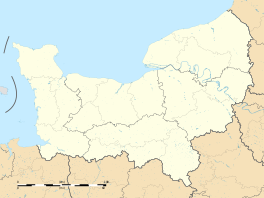Gaillon
| Gaillon | ||
|---|---|---|

View of Gaillon from the castle
|
||
|
||
| Coordinates: 49°10′N 1°20′E / 49.16°N 1.34°ECoordinates: 49°10′N 1°20′E / 49.16°N 1.34°E | ||
| Country | France | |
| Region | Normandy | |
| Department | Eure | |
| Arrondissement | Les Andelys | |
| Canton | Gaillon | |
| Intercommunality | Eure-Madrie-Seine | |
| Government | ||
| • Mayor (2008–2014) | Bernard Ledilavrec | |
| Area1 | 10.19 km2 (3.93 sq mi) | |
| Population (2008)2 | 7,052 | |
| • Density | 690/km2 (1,800/sq mi) | |
| Time zone | CET (UTC+1) | |
| • Summer (DST) | CEST (UTC+2) | |
| INSEE/Postal code | 27275 /27600 | |
| Elevation | 8–144 m (26–472 ft) (avg. 59 m or 194 ft) |
|
|
1 French Land Register data, which excludes lakes, ponds, glaciers > 1 km² (0.386 sq mi or 247 acres) and river estuaries. 2Population without double counting: residents of multiple communes (e.g., students and military personnel) only counted once. |
||
1 French Land Register data, which excludes lakes, ponds, glaciers > 1 km² (0.386 sq mi or 247 acres) and river estuaries.
Gaillon is a commune in the Eure department in northern France.
The origins of Gaillon are not really known. In 892, Rollo, a Viking chief, might have ravaged Gaillon and the region, before he became the first prince of the Normans and count of Rouen in 911.
The Gaillon history did begin, when the first dukes of Normandy built a keep to defend the border of Normandy against their enemies : the kings of France. The first castle of Gaillon belonged to a whole system of defence along the Norman border such as Evreux, Pacy-sur-Eure, Vernon, Malassis, Gasny, Baudemont, etc.
In 1192 King Philip II Augustus of France seized the castle in his battle with Richard the Lion Heart to conquer Normandy. Richard decided to build a new one a few kilometers away in Les Andelys on the other bank of the Seine River : Château Gaillard.
In 1262 the castle was exchanged between King Louis IX and (Archbishop of Rouen) and it became the residence of the Rouen archbishops until the French Revolution.
In 1419 the city was put under siege by Thomas of Lancaster, 1st Duke of Clarence and his English army. It was subsequently retaken by the French, and then by the English. Five years later John Plantagenet, Duke of Bedford, ordered the demolition of all fortifications, sparing only the home of the archbishop.
...
Wikipedia



